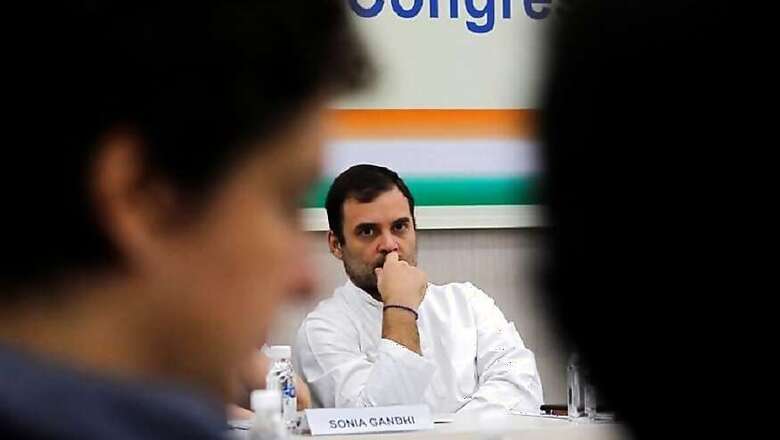
views
For those planning a holiday during the winter in the scenic Andamans, the gateway for them would be through the Veer Savarkar airport. One of the must-visit destinations on the island is Cellular Jail, where freedom fighters were incarcerated after being transported for life by the colonial government.
A very well-researched light and sound show at the gaol complex, where Savarkar was jailed twice, tells the Savarkar story in detail. A nation which recognised him as a freedom fighter, issued a stamp in his memory and named an airport after him is suddenly debating his antecedents.
Former Congress president Rahul Gandhi has done little service to the nation at large and to his cause in his ideological battle against BJP by belittling the contribution of the legendary freedom fighter. Gandhi at a rally last week in Delhi had said that he was ‘no Savarkar’ to apologise to the government for his political stand.
The debate on Savarkar in the past few months has been more entrenched in the effort of creating ‘likes’ on social media or TRPs on the creativity-starved television news channels than any serious historical discussion. The whole debate on Savarkar’s contribution unfortunately has got embroiled in a comparison with the Congress leaders.
Those picking up the cudgels for Savarkar have chosen to target the Congress leaders, especially India’s first prime minister Jawaharlal Nehru, and, to some extent, the father of the nation, Mahatma Gandhi. Those defending Nehru and Gandhi, have countered, claiming Savarkar to be a British stooge and being part of the conspiracy to assassinate the Mahatma.
There is no doubt that Nehru spent 15 years of his youth in jail, renouncing a life of luxury. His liberal education complemented the efforts of Vallabhbhai Patel and Mahatma Gandhi. These three and others of the Congress sustained the freedom struggle for four decades. There cannot be denying them their due as Savarkar, too, should be given credit for his efforts.
To understand Savarkar’s contribution, one has to see his personality in totality and not in bits and pieces. A British stooge and pensioner, as some are claiming him to be, could not have been jailed in Andaman twice. At the Cellular Jail, Savarkar lived in a cell on the second floor in solitary confinement. His cell was last in the row and next to the building wall was the hanging room.
Several times, he was subjected early morning to cries of co-prisoners being hanged. To him, this psychological torture was more difficult to bear than the physical labour he was made to go through. The Cellular Jail in matters of treating prisoners was no less than a German concentration camp.
Coming back to Gandhi and Savarkar, there is an interesting mention about their meeting in an article published in the Economist in 2014. It mentions, “In 1906, in a lodging house for Indian students in Highgate, a pleasant area of north London, a young lawyer called Mohandas Karamchand Gandhi dropped in on a law student called Vinayak Damodar Savarkar, who happened to be frying prawns at the time. Savarkar offered Gandhi some of his meal; Gandhi, a vegetarian, refused. Savarkar allegedly retorted that only a fool would attempt to resist the British without being fortified by animal protein.”
Whether the story is mythical or real is a matter of examination. Nevertheless, it is a reflection on how the two approached the issue of freedom. While Savarkar believed in a virile approach, Gandhi was seen by him as being weak for his non-violent ways.
India’s freedom movement was spread over nine decades. It began with the Sepoy Mutiny of 1857. Thereafter, a whole lot of leaders and groups emerged who fought for freedom, propelled by their own understanding and belief. While Gandhi was a pacifist and with inclusive attitude towards all religions, Savarkar believed that the Hindu identity was inseparable from the Indian identity. But both embraced difficulties in fighting for the nation’s freedom.
The Economist article, though, mentions that the meeting between Gandhi and Savarkar saw the beginning of ideological hostility, but this, however, did not stop Gandhi from pleading before the British to accept Savarkar’s mercy petition, who was then lodged in Andamans.
The filing of mercy petition was then part of the process of law, somewhat similar to the present-day appeal against a lower court order in a higher court.
Savarkar was extradited to India, tried and sentenced for the murder of ATM Jackson, collector of Nashik district, and brought to the Andamans in 1911.
Interestingly, some of Left-wing historians regret the fact that he got away in the case of the murder of Curzon-Wylie of the India Office in 1909, in which Madanlal Dhingra was convicted and sentenced to death. These very historians blame him of having ‘begged’ the British for the next 10 years through several mercy petitions and making offer of joining the British efforts in World War I.
Can these be held against him without debating the act on a wider spectrum? Gandhi, too, had supported the allied forces during World War I. Does that make him a leader of any lesser stature? These incidents are not to be seen in isolation but entirety, so is the case with Savarkar's apology and pension.
It’s without doubt that the Congress played the biggest role in getting us independence and thus the narrative of non-violence rightly came to dominate the description of the freedom struggle.
This, however, in no way should dwarf the role played by parallel movements towards supporting the cause of liberation, be it those led by Bhagat Singh, Subhash Bose or Savarkar.
(The writer is a senior journalist and political analyst. Views are personal)

















Comments
0 comment